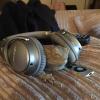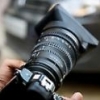Search the Community
Showing results for tags 'Workflow'.
-
I do have some quite significant problems with the pen tool. I have to cut out complex forms and use the Pen Tool to create the outline. Within AP it often happens that points close to each other are not set (instead the last point gets pre-selected). Effectively a new point can't be set within a certain distance to the last point (so constant zooming in and out is required to set nearby points!). Not always beeing aware of this since I'm setting hundrets of cornerpoints the curves closes unwanted and a new curve starts. This is very annoying since I have to go back in history or even delete many points since I did not instantly realise that a new curve has been created. Comming from PS where I never experience these problems it is a serious hurdle in AP and one of the reasons I still get back to PS for this task since the workflow is far less error prone and it takes up a lot less time. In PS you can't accidently close a curve, getting to close to the last enterd point will add a bezier-curve instead of a line what is not a big deal. Maybe someone can have a look into this and improve the handling of the pen tool to make usage more efficient. As well the history function sometimes fails when working with the Pen Tool (experienced that in other situations as well). Cheers, Timo
-
Hi everyone, here´s a Questin comming from our PR appartment. We are Architects, and our Company produces Plans and views of Architectural Projects using CAD software, that will be printed as PDF files.. now, when importing them, Illustrator, as well as Affinity Designer seperate lines ore layer with for example dotted lines or to exploded separated lines.. so you get hundredts of seperated single shapes, that before belonged to for example ony on Autocad line, that was just told to be dotted... and.. using Designer or Illustrator kills the possibilty to change their look afterwords. nevertheless, Designer seems to organise the seperated shapes a little bit further into Groups, and my question now is, can i just select the segments inside of such a group and combine them into one single easier editable curvesegment ? is there a way `?
-
Hallo dear people from affinity, first i have to admit , that i love your program. It allready has got a very complete and great toolset when it comes to refining images and photos and for sure is on one level with Adobe photoshop, just for an increadible smal amount of money.. After researching the toolset of this program for my architectural company, i still can say it is a great program. But there are areas of the program, that are just much slower , thinking of the workflow of a usual architectual company, and the way Architects have to deal with competitions. Especialy in this area, in this most important workflow for architects, the way we have to construct Plans, Affinity Photo is not on one level in comparison to Photoshop. So i hope very very much, that this can be improved. So please dear people of Affinity Photo, take my post to your develloperteam, and have a look at it. I know making Software is a complicated task, and even more, because you have to deal with compatibility tasks to other Companys, that for sure won´t like to help you (thinking of pdf files.... for example).. But even Germany has got about 130 000 Architects, and most of them at the moment depend on using Photoshop at some moment in Competitions, So just think of this market... . and maybe in a later release, we can get an improved workflow also for architects and not only for photographers... thanks.. so here comes a link to a video i recorded just to show you the workflow of Architects, using Affinity, compared to Photoshop..
-
Hi everyone, i found a secound real Problem in using Affinity Photo as a replacement for our Photoshop inhouse workflow. The first and even bigger Problem is, that Affinity Photo imports and embedds PDF files printed from CAD applications as a vektorfile, and not as a pixellayer.... the reason for this is that affinity photo for sure tries to stay flexible so you can still change the curves. but in this case this is nonsense, because you allways make the changes in CAD applications. and so, you get an embedded vektorlayer, which has strong antialiasing problems in between of the fillings.. ....... i ll get to this back later in another post, even when this Problem is allready known. Just because this workflow problem, prevents the whole architektural society from using affinity photo, which is very sad and could be solved " easily" (maybe its not ?) by just importing pdfs as rasterised layers that are embedded.. just like in photoshop... (So i developed a Workaround for this by using layer effects, coloring an embedded pdf and after this putting a outline in the same color on top, to fill the antialiasing gaps..) Now here comes a good message.. in afinity Photo 1.6 i can decide to just print my contend and also the embedded pdf files and overwrite the used 300 dpi, in the print dialog, and use for example 1200 dpi. so in the printing i can get rid of the antialiasing seams inside the pdf file, while i can still see them in the viewport. But the print is allright. but now the Secound problem for this post.. When using the embedded pdf, Architects often use differing colors inside the embedded file, and i need to make selections from those differing colors. THIS at the moment doesnt work .. i have to duplicate the embedded pdf, rasterise it and than make the selection from the rasterised file, use it, and afterwords delete the pixellayer.. THIS costs so much time again, that the architects in my company will kill me if i force them to use affinity photo. is there any other way to get a solution from this ? i put a screenshot for clarification to this post.. please Affinity...... Help the architectural Soziety.... there are about 130 000 Architects in Germany !!! most of them that do Competitions use this one workflow to print pdf´s and use them in Photoshop to make them better and they need it embedded... and working.. Its the one Single by far most important feature for them when they do Plans ........ (renderings are another thing).. So is there another way ?
-
Good day to you, I have a short question. I don't have a graphic tablet and I have to admit that the workflow is hardly slowed be the fact that I have to reselect the brush size in the upper left corner by clicking on it. In Photoshop is a very convinient option by choosing the size of the brush with keyboard+mouse-commands. Is it planned to inplement a similar feature in the upcomming releases? I have to be true Affinity Photo is cool but this point is the reason which slowes my workflow extremely and I really have to think about using Photoshop instead of a really great product.
-
Hello men, I would like to ask you about improve features in the Affinity Photo. Is it possible open the Location Panel in the Photo Persona? If not, could you allow it, Please? I tell you why. I would like to insert location to many my photos. I can open many final photos (post processed photos saved in Jpeg format) in the Affinity Photo. But the switch to Development persona is followed to any Pixel layer in the every picture. I can not switch affinity photo to Development persona for every opened pictures just ones. I have to open any picture, switch to development persona, insert location via location panel, hit Develop button, save (export) the picture, open another picture, switch to Development persona, ... . It is crazy. Otherwise, is any way to develop many photos from RAW format, or to change EXIF in many photos, wholesale? I think Affinity Photo is powerful tool for one picture editing. It is not ready for wholesale photos editing (RAW develop). I use Camera RAW inside the Adobe Photoshop. I want stop using Adobe Photoshop. But i am not able stop using the Camera RAW. Thank you very much Elektronek
-
- location panel
- workflow
-
(and 1 more)
Tagged with:
-
I just got the PC version of Affinity Photo yesterday and I wondered if I could change the Styles panel for the Filters panel which I use more? (Presently, Adjustments Layers Effects Style Stock) I also don't use Stock. I'm comparing to Photoshop where panel tabs can be rearranged by dragging. Also, how long should the program take to load? If mine is slower, can I adjust preferences in any way? Does having an image re-load from previous session slow it down?
-
Hi All, Anyone knows what is a good method to convert color images to greyscale non-destructively? Except the Black & White feature. I'm working on a school yearbook, most of the images is groups of children, class group images and sport group images. Thank you.
- 7 replies
-
- non-destructive
- workflow
-
(and 2 more)
Tagged with:
-
Hey guys, Just 3 days ago, and after a pretty difficult chat support session, I've completely quit my Adobe habit with the removal of Lightroom/PS, and it's very liberating. I'm now a free man! I'm now trying to finesse a photography workflow with the Affinity apps front and center. My current setup is I own Photo for both OSX and iOS but after the last couple of shoots I'm finding it very difficult to replace Lightroom in there. Now, I know the fervor of an Affinity DAM is pretty intense, and I also know that it's confirmed for development, but I'm sure we won't see it for quite some time yet. Therefore, what do you guys use in it's place as of now? I should also mention that because the storage space on both my iPad Pro and my MacBook is fairly limited, I keep all my files in a master folder on Dropbox and use oDrive to sync/unsync my files as I need them. With Lightroom, my old workflow was as follows: Move images from camera to new job folder on OSX, they then get auto synced to Dropbox by oDrive Open images in LR and save LR catalog file in the same folder as the images are in (again, gets fired up to Dropbox by oDrive) Do required edits to images in LR, and on exit LR will auto update catalog with newest data and edits Unsync new job folder with oDrive and everything gets auto synced to Dropbox Pretty much it. The devs at oDrive said they are releasing a mobile version of thier app - which is fantastic news and that would certainly make life easier to use with AP on iOS. So, what does your workflow look like? I'd like to find one that preserves non-destructive edits in the way LR cataloging used to. Not played with AP too much so really not sure if it's already included functionality. Cheers, Stu W.
-
Not directly affinity photo ipad related, but maybe the community can help me out here. I'm a starter in photography, have a serveral hundered raw files to work with and are looking for an ipad pro 12.9 with affinity ipad. (My old macbook is slow and does not last lang on battery anymore, dont want to buy a new one, i already do everything on my normal ipad mini and iphone) So i am looking for a complete mobile workflow, i saw that i can use diffirent cloud spaces so place anough to store the raw files. But who has experience with organizing and add taggs to the edited photo's? which app is the best for this, or any tips and tricks are welcome. Thanks guy's
-
I have my photos organised in LightRoom 5 and got Affinity Photo because PS was getting ridiculously expensive for my limited use. My RAW processing and basic adjustments are done in LR, and the majority of photos are just exported from there, I have a reasonable feeling of how to work with it. I then go into AP for things where more detailed work is needed, for example I did exposure stacking to make star trails. As I am hardly using the Develop Persona, how/where/when do you suggest I sharpen? Sharpening is a bit of a dark art to me...
- 2 replies
-
- lightroom
- sharpening
-
(and 1 more)
Tagged with:
-
As a landscape photographer I take a lot of exposure bracketed photographs. For a while I used to blend these exposures using HDR software, until I learned that there's a better way that produces a more natural-looking result and gives the photographer more control: manual exposure blending. Affinity Photo includes an awesome "Blend Ranges" feature that I use to accomplish this task. It takes a little practice, but this tool is more flexible than Photoshop's "Blend If" sliders (because it supports customizable and non-linear luminosity feathering), and more efficient than Luminosity masks (smaller file size). However, the process of actually setting up multiple exposures as layers ready to be blended in Affinity Photo is currently pretty manual and tedious. You have to open one or more of your files, and then drag the others in to create additional layers, or create a new stack and then cancel the stack to unstack the layers. I do this frequently enough that it's irritating that this isn't more efficient. Since switching to Affinity, I really miss the streamlined workflow from Adobe Lightroom, where I can select multiple images and choose "Open As Layers In Photoshop," which takes care of all of the setup for blending multiple exposures, with the added bonus of also not creating multiple intermediate PSD or TIFF files. Now, obviously Adobe has no incentive to support an "Open As Layers in Affinity Photo" option for Lightroom out of the box, but perhaps an enterprising developer could write such a plugin for Lightroom if only Affinity Photo would actually support the ability to open multiple files / data streams from a RAW processor as layers in a new file... In my dream workflow, it would be really neat if Affinity Photo integrated directly with Phase One's Capture One PRO, for a similar workflow to how Lightroom integrates with Photoshop. Perhaps Phase One would be receptive to such a collaboration... I suppose the gist of my feature request is that Affinity Photo is a fantastic program, but sorely lacking in some workflow/efficiency areas that matter quite a lot for people working with lots of images. Adobe, for all their faults, seem to have figured this out, and their ecosystem of products that work together is a great strength of their offering. In the absence of a similarly large suite of complementary apps, Affinity would do well to offer some basic hooks into Affinity Photo that developers can use to create a better round-trip experience when users are working with multiple apps in concert to catalogue and edit their photos.
- 11 replies
-
- feature request
- improvement
-
(and 1 more)
Tagged with:
-
Being one of those designers who works individually I am really cheesed of (I would like to use a stronger in my comment!) with Adobe pricing policy and therefore looking for alternatives to their products. Looking forward to Affinity Publisher being launched in the future, sounds as though it could tick all the boxes. Will it allow the opening of InDesign files without an additional plugin? Will it recognise Adobe eps files too? Hopefully if it does, then being able to interface with my past work files will be the killer for Adobe bandits.
-
Hi folks, Sorry if this has already been requested, I couldn't find a thread showing that it had so hopefully I am not duplicating. Are there any plans to introduce a feature to Affinity Photo (Or even create a stand alone app) that would offer the same workflow management that Lightroom (Sorry I know it's a swear word) has? I would love to use Affinity Photo as my go to software for all my photo edit work but it would be handy if I could arrange and sort all of my shots from a shoot within Affinity Photo and not have to use a third party app to manage them such as the Macs native photos app etc. It would also be VERY handy to be able to apply edits across multiple photos at the same time. Cheers folks Mark
-
- affinity photo
- lightroom
-
(and 1 more)
Tagged with:
-
After really getting into using the iPad for editing over the last week, I have come up with a few things that I think would really help improve the speed of general workflow: 1) One powerful tool in the tutorial videos takes a number of steps, and are thus kind of cumbersome - it's creating the non-destructive dodge/burn layer. You have to create a new pixel layer, fill it to 50%, set the blend mode to overlay, then finally you can dodge/burn on that layer. So why not have another option in the "+" menu for layers, where instead of adding a pixel layer you can "add neutral overlay" which does all that in one step. Honestly it's what I thought "Add Fill Layer" would do, I can't figure out what that actually does though. 2) I have a small set of Adjustments/Filters that I use regularly. I know you can change between sections like Noise/Colors/Blurs instead of all filters, but for both Filters and Adjustments it would be great to have a set that was "most used" and give you 6-10 of your most frequently used options. 3) It's great that I can copy groups of adjustments into another images, quickly change the mask under the group, and get an effect I like applied to a part of the image quickly... but I end up doing that with a few different kinds of adjustments, so it would be nice to be able to create some kind of palette with groups of adjustments/filters already set to specific values that I can bring into an image. One practical example is a set of adjustments for skin smoothing, I like to use a combination of Bilateral Blur & Diffuse glow at very low opacities to get close to the skin smoothing I used to get from the Nik ColorEFX 4 filters. Thanks for a great tool, as a data point for you I get all my files in and out through iCloud (which has been working really well so far).
-
Since I'm trying to work with AP and AD nearly on a daily base I'd like to point out one of the (from my working experience) most anoying and down-slowing topics of AD and AP. It's the lacking ability to save hardly ANY (user defined) setting within the program! Mainly when it comes to content of dialogs, standard presets, program or document relateds setting ... hardly anything is saved and can be recalled in any way so one hast to start all over and over again entering the same values. What a constant waste of time you are requesting from your users! Setting the gaussian blur values for each photo again and again, changing from a bilinear sample method to bicubic, an unsharp mask filter that always and unchangeable starts with unsuitable initial values ... this list is nearly as long as the featurelist of the programs. And sadly enough the standard setting in many ways are completely useless! I'm very aware that there is quite some programming effort involved to change this ... settings can be document depending, session depending or a general setting. It may lead to changes in document format and program setting (what is obviously something developers try to avaoid). But please tell AP and AD users, that you are aware of this problem and you're trying to fix it! Cheers, Timo
-
I love the variables that I can use in the export settings for each slice. However, I miss a variable that holds the name of the document. Whe I export slices of images from multiple documents, this would be very helpful for leter finding the source document when I recognize I a mistake when looking at one of the exported slices.
-
Since Macros regrettfully can't be called by customized key-shortcuts (or did I miss out on an essential development step?) I need to have the workspace consuming Library panel open to work with my own Macros. I do have 5 categories within the library. Each of them contains quite some Macros (most of them provided by Serif). Since I don't need the first 4 Macro categories (with a multitude of entries) I close these categories to be able to access the few entires of my own categorie. Now each time I open up a new file all categories open up, forcing me each time to manually close all obsolete categories again and again for each document to be able to access my own macros. This drives my crazy! Even worse: when you switch to another document and switch back to your old document the categories in the library are automatically expanded again and I've got to start all over again .... this seems to be an job creation scheme on highest level Having added your new category and you're trying to overcome the above behaviour at least to a certain extend (it makes no sense to close categories since AP will open them instantly again) best idea is to move it up to the top of the list. But this expanding-category behaviour really stresses it to the very end: Each time after moving your (new and therefor last) category one step up .... the library panel expands all other categories again .... forcing you to either close all categories again or find your own categorie some where ... forcing you to repeat the procedure unltil you finally got it to first entry in the panel. Unless this is just an unlucky startup setting and it can be changed somewhere within the program (where I haven't found it yet): Please let the library panel save the customer selected settings of the panel automatically (this would be really helpful for many panels!). Please keep it saved for each document seperately. Don't expand any categories automatically! I know by know that many people here keep rolling their eyes when I start mentioning the word "workflow" since noone seems to care for such things or wants to improve in this area but I seriously hope this will change in future when more people will use AP on a daily and professional base .... Cheers, Timo
-
I just wanted to recap the current state of how Affinity Designer is performing in web design workflows. I'm using Affinity Designer since one year for all of my work and I love the application itself. But as of now there is no complete workflow to handout designs made in AD to developers in any way: 1. Neither Zeplin nor Avocode support AD and it doesn't seem that anthying will change here. 2. Affinity Designer supports PSD Export but has two major drawbacks: Border radius properties are not preserved and text layers are completely flattened which make them completely useless. 3. Affinity Designer doesn't support the new open file format of SketchApp to be able to export designs as Sketch files to then inspect them in Zeplin, Avocode, or any other Sketch Viewer. 4. Exporting to SVG or PDF is not an option either because important properties like border radius, line-height and others are missing. 5. Right now it doesn't seem that Affinity is adding an inspect persona or any viewer service or app. So I'd like to ask the Affinity Designer team: What are your goals to improve the workflow for webdesigners and developers? How are you planning to improve this workflow in the future or don't you plan to do anything in this regard? Do you have any suggestion how web designers can work with developers? I've added a poll so that users can vote which suggestion they like the most.
- 11 replies
-
- coding
- border-radius
- (and 12 more)
-
After having used the 32-bit modes almost exclusively now since we had them available I noticed some issues with OCIO configurations and maintaining them. What I'm suggesting is a more global config file. I've attached a YAML example. YAML because it's easy to read, duplicate and modify. It can be easily exchanged when working in groups. Download project config from Shotgun, merge with own config and use it right away. Affinity currently has a config switcher that doesn't switch configs. This way it would work and it would be easy for the user to manage. The ICC part is for Affinity to determine which profile is used for converting OCIO data to ICC data for delivery use to devices and services that don't use OCIO (print shops for example). ocio affinity.yaml
-
Greetings, Affinity Photo is now my main photo editing software. I also like to use ON1 Photo RAW 2017 for some features, especially the PHOTO FILE MANAGEMENT system. ( or Digital Asset Management ) Whenever I tell ON1 Photo RAW 2017 to edit the image in affinity photo, it opens the image in affinity photo brilliantly. However, I am having trouble understanding what happens when I exit Affinity Photo to go back to ON1 Photo RAW 2017. How can I keep the original and the edited file on the same folder in a way that makes sense? Since ON1 Photo RAW 2017 doesn't recognize .afphoto format, it won't display it in the ON1 Photo RAW 2017 file browser/organizer. Is anyone here using this same combination? What is your workflow like when working from one of these apps to the other? Especially when keeping everything non-destructive. Cheers! William
- 6 replies
-
- on1
- affinity photo
-
(and 2 more)
Tagged with:
-
Not sure if this has been addressed: It it would significantly improve the AP app experience if users could create tailored workflows easily and then batch process multiple shots using AP and Workflow, together with other suppported photo apps, to automate the current tedious one-photo-at-a-time procedure. I would be happy to help with the development of this feature, as it would greatly benefit many photogs I know who are interested in making the switch from traditional PC laptops to the iPad Pro.
-
Hi there, are you considering to really support a mobile professional workflow? Coming from a job (e.g. wedding), I have thousands of raw images which I have to go through and select the best ones to be edited. Back home, I would like to store them on my NAS and synchronize a specific folder with my iPad. I could then do the culling on the roads, e.g. sitting in a train (offline). Back home, the ratings should again be synchronized to my NAS so I can start editing the best ones on my iMac. Edited photos should then be synchronized via NAS to my iPad, so I can show them to customers... I definitely want to sync via NAS, because I easily end up with more than 100GB of images after a wedding. There must not be any cloud storage involved because this slows down the entire process! Additionally, for travel photography it would be great to back up to my iPad first while traveling. I could then start rating the images with star ratings and synchronize the result as soon as I am back home. This means I neither have to carry a laptop to choose the best images, nor do I have to wait with the rating and selection of my images until I am at home... For my personal images it would be great if all edited photos could be synced to my photos roll on iMac, iPhone and iPad via NAS (with the time when my images were taken, not when they were edited...) looking forward to hearing from you chris
-
I'm sure you've given it thought but do you see changing the term "persona" or how AP/AD categorize these sections? Is this a "legal" get around? Only reason is that "Lightroom" for example has a similar thing in how they break up their workflow, but it's sort of laymen and it truly follows a workflow, oppose to Personas which feel random and honestly confusing. I would love to see this portion of the apps overhauled so it really becomes useful in a professional environment and follows a realistic workflow. Yes, it' different for everyone but at the end of the day, "1, 2, 3, 4 and 5" makes sense, not "3, 5, 1, 4 and 2". Love the product but just an observation that I hope will be addressed.
-
I wonder why it is still possible to apply a fliter to an adjustment layer? Are there any cases where this makes sense? A warning would be helpful or the filters just greyed out. There are other things that also make no sense (for me): - A brush (or a layer) with zero opacity - A white brush on a 100% white mask - Eraser on an empty mask
















